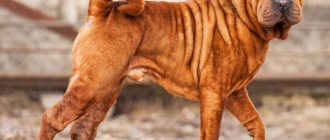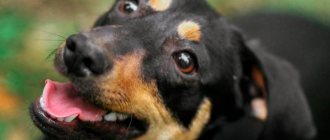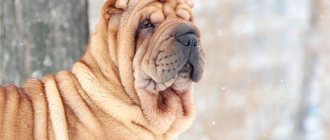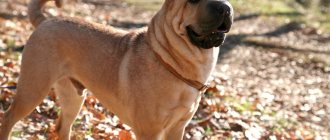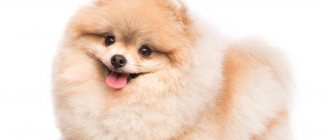Brief description
- Height : minimum – 44 centimeters, maximum – 51 centimeters.
- Weight : 18-25 kilograms.
- Characteristic color : any solid color, except pure white, spots are unacceptable.
- Coat length : short, hard, without undercoat.
- Lifespan : 8-10 years.
- Advantages of the breed : has excellent watchdog and security qualities. Gentle towards children.
- Difficulties of the breed : willful, prone to dominance. Often suffers from food allergies.
- Dog price : Undocumented Shar Pei puppies cost from $100 to $200, the price of a puppy with an excellent pedigree can range from $500 to $1,500.
Grooming
With all the variety of colors, Shar Pei fur can only be of two types:
- horse - hard short bristles, no more than 1 centimeter in length, no undercoat;
- brush - softer than horse due to the elastic guard hair, the coat is thick, but also without undercoat, the length of the coat can reach 5 centimeters.
In both the first and second cases it is minimal. They do not need to be trimmed or taken to a groomer due to the lack of undercoat. Moreover, such grooming methods will be too rough for the dog and will cause skin irritation. Therefore, it is recommended to simply comb the dog to help it get rid of dead hair.
It is better to scratch Horse Shar-Peis once a week, and brushed Shar-Peis a little more often.
You need to bathe your pet once a month. In this case, it is better to use zoo shampoo. Human hygiene products will be too aggressive for the delicate skin of a Shar Pei.
For the same reason, it is important to rinse well and then dry each fold.
You can also use baby powder or dog powder to remove moisture from hard-to-reach places on your pet’s body.
There are many color options for Shar Peis. Perhaps no other breed can boast such diversity. Thanks to this, every breed lover will find his pet. And no matter what the Shar Pei is - standard or not, he will definitely be devoted to his owner.
History of the origin of the breed
Shar Pei is considered a very ancient breed; dogs with a similar genotype lived in China three thousand years ago. Over such a long period of its existence, the breed experienced periods of popularity and almost disappeared during the reign of Mao. In the seventies, Shar Peis were even listed in the Red Book as the rarest dog breed.
The credit for the revival of the breed belongs to American cynologists, who over the course of several years, using about a dozen purebred sires and infusing them with the blood of dogs of other breeds, saved the Shar Pei gene pool .
In subsequent years, the breed gained recognition all over the world: puppies, similar to small hippopotamuses, are unusually cute, and adult dogs inspire respect.
General characteristics of the Shar Pei breed
Many people know what a Shar Pei looks like - a dog with a large wide head, short hair and folds on the body. This ancient Chinese breed is now one of the most popular, although until recently it was on the verge of extinction.
These dogs are valued not only for their unusual appearance. They are smart, easy to train, and good-natured. And at the same time strong and fearless. A Shar Pei can become a reliable guard, protector and nanny for a child. Suitable even for homebodies and inactive people. But this breed is not without its shortcomings; the Shar Pei is an independent dog and loves to dominate. She requires the unquestioned authority of her owner and early socialization.
| Options | Characteristic |
| country of origin | China |
| breed registration time | 1981 |
| group of breeds according to the ICF classification | Molossians, mastiff subsection |
| height | female 44-48 cm, male up to 51 cm |
| weight | female 18-25 kg, male up to 35 kg |
| life expectancy | 9-11 years |
| activity | average |
| attitude towards a person | not aggressive, but friendly only with family members |
| intelligence | smart |
| health | bad |
| care needs | medium, sheds little |
| working qualities | security guard, bodyguard, watchman, hunter, companion |
pros
This Chinese breed has only recently become popular throughout the world. Dog breeders immediately noticed her advantages, unusual appearance and easy-going character. Shar Peis have lovers who consider them the best pets. This can be explained by the many advantages of owning such dogs.
- Shar Peis live quietly at home. Thanks to their small dimensions, you can keep these dogs even in a small apartment. They are unpretentious and adapt to any conditions.
- Suitable for families with children, elderly people, single people. They do not require much physical activity.
- These are obedient dogs that become attached to their owner and strive to please him. Therefore, they are easy to train.
- They do not conflict with other animals, but react adequately if they or their owner is in danger.
- Shar Peis have a balanced, peaceful character. They do not bark for no reason, they behave calmly at home, even a puppy will not chew furniture or shoes.
- These dogs are clean and avoid dirt on the street. They learn to use the toilet quickly, and an adult dog will never crap in the house. There is no dog smell from the fur.
- This is a good watchman and security guard, a devoted companion. For a child and teenager he will become a faithful friend and protector.
Minuses
But these dogs need an experienced owner who can maintain authority and give them enough attention. The Shar Pei has the following disadvantages:
- in the absence of socialization, can be aggressive with strangers;
- strives to dominate, can be stubborn, touchy;
- is very attached to the owner, does not tolerate loneliness;
- if a dog's lips are saggy, he often drools;
- has poor health;
- tendency to gluttony, obesity and food allergies.
Interesting facts about the breed
This ancient Chinese breed dates back several thousand years. Therefore, many interesting facts about her have accumulated.
- The name of the breed translates as “sand skin.”
- This is one of the most ancient breeds. There are images of similar dogs from three thousand years ago.
- Because of its blue tongue, the Shar Pei was called “the dog that licked the sky” in ancient China. It was believed that they could ward off evil spirits.
- The Shar Pei is the dog with the most recognizable appearance. Many folds on the skin, a stocky build and a wide muzzle - these features are unlike other breeds.
- These dogs cannot tolerate restrictions of freedom. Violence, even being examined by a veterinarian, can cause them great stress.
- Despite the fact that the Shar Pei's coat is short and sheds lightly, they often cause allergies.
- One of the unusual characteristics of the breed is monotony. Some individuals have a nose, paws and skin colored in the same way as their fur.
- In the 70s of the 20th century, the Shar Pei was included in the Guinness Book of Records as the rarest breed.
You can also learn interesting facts about the breed from the video:
Video: Interesting facts about the Shar Pei breed
Purpose of the breed
Shar Pei is such a versatile breed that in China it was used as a guard, herding and fighting dog , helping its owners in everything. It was impossible to find a Chinese family where a Shar Pei did not live, and this small dog could hunt large game, guard the home and babysit children, and also earn money by participating in battles.
In modern conditions, the fighting qualities of the breed have faded into the background, and the main task of these dogs in the city is protecting the owner and territory , as well as playing the role of a companion dog. The Shar Pei's high mental qualities and his ability to subtly sense the mood of people living nearby make representatives of this breed indispensable in everyday city life. Shar Peis are hardy and active dogs; they can easily withstand physical activity , but are able to easily adapt to any lifestyle.
Top 10 strongest breeds
Which breeds are stronger than others? In addition to outstanding, famous individuals, there is also an unofficial ranking of the top 10 strongest dogs in the world. It consists of the average indicators of the power and strength of its representatives.
To get into the top, there are general physical criteria: height from 60 centimeters, weight from 50 kg. So, we present the ranking of dog strength and power.
- Saint Bernard
- Newfoundland.
- Central Asian Shepherd Dog (Alabai).
- Akita Inu.
- Leonberger.
- Boerboel.
- Tibetan mastiff.
- German dog.
- Dogue de Bordeaux.
- Cane-conso.
Let's get to know these giants better.
1. St. Bernard - without exaggeration, this is the strongest breed of dog in the world. This breed was bred in the 17th century by monks from the monastery of St. Bernard to rescue people from avalanches on the Great St. Bernard Pass.
For example, the famous St. Bernard Barry once carried a boy for 5 kilometers across virgin soil. Weight 45-90 kg, height at the withers - 70 cm. Also included in the rating of the largest breeds.
Saint Bernard
2. Newfoundland. This is also a rescue breed, but it is adapted for assistance on the water. She even has webbing between her toes!
Naturally, in order to pull an adult, often chaotically moving person out of the water in difficult conditions, great strength is needed, and this giant has it!
The breed is also used for transporting firewood and other heavy loads. Adults weigh 70-80 kg. Included in the rating of the largest pets.
Newfoundland
3. Central Asian Shepherd Dog (Alabai). An indigenous breed from Central Asia, used as a herding, service, and guard dog. Descended from the most ancient Asian and fighting breeds of Mesopotamia. For many centuries, Alabai (it would be more correct to say “Central Asian Shepherd Dogs”) guarded flocks from wolves and jackals, which naturally made the breed strong. At the withers 70 cm, weight – from 50 kg.
Central Asian Shepherd Dog (Alabai)
4. Akita Inu. One of the oldest breeds, it was used for hunting large animals. Another name for the breed is “matagi-ken”, which can be translated as “bugbear”. Two dogs were able to hold off a bear! They also hunted wild boars and deer. Height up to 70 cm, weight up to 64 kg.
Akita Inu
5. Leonberger is the fruit of crossing St. Bernards, Newfoundlands, and Pyrenean dogs. It inherited the qualities that make it possible to rank this breed among the strongest from its ancestors. Can be used as a guard, shepherd, water rescuer. Average height and weight – 70 cm and about 70 kg.
Leonberger
6. The Boerboel is an African dog that is banned in some countries. Hunters and guards took part in baiting predators. Height up to 70 cm, weight up to 90 kg.
Boerboel
7. The Tibetan Mastiff is a rare breed known since antiquity. There are many legends about her. She was a watchman and helped her owners in the Himalayas. They say that the specific booming bark of the Tibetan mastiff can stop a snow leopard. Outside of Tibet, it often protects herds from predators. Height up to 77 cm, weight up to 80 kg.
Tibetan mastiff
8. Great Dane is a service breed. Descended from Asian fighting dogs. Previously, there were subspecies: large individuals became guards, smaller ones hunted wild boars and bears. At one time, the Emperor of Russia Alexander II really liked the breed. The standard body parameters of this breed are outstanding: up to about 80 cm in height, about 90 kg in weight! The world record for height at the withers belongs to a Great Dane named Zeus.
German dog
9. Dogue de Bordeaux is an ancient, one might say antique, breed. In the past, it was a fighting dog (participated in bullfights!) and a hunting dog. Butchers' shops were often guarded. The height of males is up to 68 cm, weight – from 50 kg.
Dogue de Bordeaux
10. The Cane Corso is also called the Italian Mastiff. Descendant of Roman military dogs. Representatives of this breed took part in gladiator fights. They protected the herds from predators. In Italy there is a saying “brave as a Corso.” Height up to 72 cm, weight up to 50 kg.
Cane Corso
Shar Pei character
When meeting any representative of this breed for the first time, a stranger will be struck by the dog’s somewhat unsociable appearance and gloomy, concentrated gaze. At first glance, these dogs are incorrigible pessimists, but once you get to know each other better, a kind, cheerful and tactful dog .
- The main quality of the Shar Pei is its self-sufficiency and desire to dominate, and these qualities are already evident in puppyhood. A pet, starting from three to four months, begins to test the “strength” of all family members, and it is important not to succumb to its provocations. Dogs of this breed very accurately understand the hierarchy of their family , and consider it unnecessary to obey low-status household members, such as children.
- Shar-Peis greet strangers warily, not allowing familiarity. suspicious noise outside the door will not cause heart-rending barking , but the dog will be ready to meet the enemy face to face.
- The fighting qualities of dogs of this breed can lead to aggression towards other animals; males are especially aggressive, they are not embarrassed by the size of the enemy, and they are ready to get into a fight with any unfamiliar male . In relation to dogs and cats living with them in the same territory, Shar Peis are friendly and often make friends with them.
- An interesting feature of the Shar Pei’s character lies in its instant metamorphosis: from a phlegmatic animal sleeping for days - into a dog sparkling with energy and joy. If the owner is busy with his own business, then the dog sleeps almost all the time, but as soon as the owner takes the leash, the Shar Pei turns into a choleric person .
- The pet of this breed has well-developed intuition and prefers to build relationships with the owner on the principle of mutual respect. He will carry out any order of his master only if he recognizes him as the leader. The dog is friendly with the rest of the family, loves everyone in the household and adores small children, but all children’s games with the dog must be supervised by an adult.
Pros and cons of the breed
The division into advantages and disadvantages of Shar-Peis is quite arbitrary. What one person may see as a disadvantage of a dog, another will regard as a positive feature.
Advantages
Attractive appearance is something that cannot be taken away from Shar-Peis. These dogs attract attention. In France, where the breed is popular, there is a proverb: “When you come to visit with a Shar Pei, you need to be prepared for the fact that he will receive all the attention.”
You can choose the color you like - the standard is loyal to the color of Shar-Peis. Any solid color other than white. And the animals themselves provide the future owner with a good range of colors, both basic and diluted (without black pigment).
The friendliness and affection of the dog is at the highest level. Shar Peis completely trust the people they live with and do not show aggression themselves; they are ready to play, walk, and help.
Loyalty to the owner is not empty words. Shar-Peis are wary of strangers, expecting a trick. They will never take food from someone else's hands or allow themselves to be petted. But in the company of the owner, the dog is ready for any event.
Security and watchdog skills have been developed in the breed for centuries. The Shar Pei, without a moment’s doubt, will defend its owner and his property, and his skills will make his actions effective. The “plush” appearance does not prevent the Shar Pei from having a powerful grip and massiveness.
The ability of Shar Peis to be trained is due to their developed intelligence and desire to please the owner. The dog remembers commands instantly.
Friendship with children will take place if the puppy knows them from a young age. In this case, he will perceive the child as a full-fledged member of the family, worthy of trust and leniency in close contact. For teenagers, the Shar Pei will be an ideal playmate.
Low maintenance requirements - the short coat of the breed does not shed, they have no undercoat. Neither frequent bathing nor constant brushing is required.
The calm disposition of the dog will not cause problems: Shar-Peis will not make unnecessary noise, be capricious, or damage furniture and things.
The breed is designed for living in an apartment - despite its external clumsiness, the Shar Pei does not need much space. The fur does not shed. With timely long walks, the Shar Pei will feel comfortable even in a small apartment.
Flaws
Jealousy and vindictiveness - a dog of this breed will not tolerate the presence of other animals on “its” territory. If the child was born when the Shar Pei was already in the family, the dog’s adaptation to the new family member will be long and difficult. And attempts by small children to cuddle a pet will be perceived as an invasion of personal space. Shar Pei can bark and bite - he does not intend to endure pain and inconvenience.
The tendency to a variety of diseases and food allergies is a consequence of the difficult history of the breed. Crossing with other dogs and inbreeding helped restore the Shar Pei population, but also added problems. Any new product is added to the Shar Pei’s diet in small portions, and the dog’s body’s reaction is carefully monitored.
Building a clear hierarchy is extremely important in raising a Shar Pei puppy. He is ready to obey only a real leader. Strictness when training a dog is necessary. From time to time the pet will test the owner's strength. You cannot relax, otherwise control over the dog will be lost.
The low speed of command execution has the same reason: the Shar Pei first thinks whether it’s worth it, then tries to understand how much the owner needs it.
Once he realizes what he has to do, the Shar Pei will clearly and flawlessly do what is required.
How to choose a puppy
When deciding to purchase a Shar Pei puppy, you must first of all calculate the possibilities of your budget, since dogs of this breed must be fed with high-quality food , and provide for the cost of treating the pet.
The wide range of prices for puppies is explained by the level of the future pet: puppies without documents are cheaper, since their parents most often do not have pedigrees, or do not participate in exhibitions and do not have permission to breed due to any defect in the exterior. In the worst case, such a puppy may be a half-breed or suffer from some hereditary disease. Arguments for purchasing a pet without documents:
- Cheap;
- Why do you need documents if you don’t plan to go to exhibitions;
- It is easier to keep a puppy without documents.
All of them are wrong, since being cheap can cost a large amount of money to treat your pet, but feeding and caring for a puppy of any class will have to be the same. As a pet, it is recommended to buy a puppy with a pedigree that is marked “not for breeding.” Such puppies have all the advantages of promising littermates, but have some disadvantage in appearance. Their prices are significantly lower.
Shar Pei puppies can go to a new home immediately after registration at 45 days of age, and it is best to get a small puppy . A grown-up Shar Pei, and even more so an adult dog, already has an established character, and the owner must have a fair amount of firmness and fortitude in order to re-educate the pet.
Sometimes you need to wait until the babies grow up or are born, since choosing a Shar Pei is a matter that does not tolerate hasty decisions. When choosing a puppy from several thick koloboks, you should definitely ask the breeder about the character traits of each baby. Absolutely all puppies are different from each other, and the breeder can advise which one is most suitable for the lifestyle of the future owners.
It is worth examining the tongue (it may have several pink spots on a blue background) and the bite (scissors). For a show career, it is advisable to purchase a Shar Pei with a coarser and longer coat that sticks out like needles - dogs with this type of coat look more impressive.
What to do about Shar Pei allergies
It is impossible to completely cure allergies in a Shar Pei, like in any other dog. Therapy for allergic manifestations is aimed at:
- Treatment of symptoms of allergic reactions;
- Removing the allergen from the pet’s body;
- Eliminating the allergen from the animal’s environment;
First of all, you need to eliminate unpleasant allergy symptoms. For all types and causes of such reactions, antihistamines are prescribed, such as Suprastin, Tavegil, Diphenhydramine. The dosage is determined depending on the age and body weight of the Shar Pei. For example, for a 4-month-old puppy, half a tablet of Suprastin 2 times a day is enough, and for an adult Shar Pei you need to give a whole tablet 2-3 times a day.
It may take a month for the Shar Pei to remove the allergen from its body. In this case, adsorbents are prescribed, the most common is activated carbon. For a Shar Pei, three tablets twice a day are enough; a puppy is prescribed a smaller dose. The simultaneous use of antihistamines and adsorbents is prohibited; it is best to give the former 2 hours before taking the latter.
Eliminating allergens from the dog’s environment is the most difficult stage. Treatment depends on the cause of the allergic reactions. If the problem is insects, you need to remove them from the Shar Pei’s fur; allergies from plants can only be eliminated by limiting walks with the dog during the seasonal flowering period of such plants. Food allergies can be triggered by any component of the diet. It is necessary to conduct tests to identify the allergen in food and eliminate it.
Care and maintenance
The Shar Pei's coat does not have an undercoat, so it should not be kept outside. This is a dog for living in comfortable conditions , since they cannot tolerate extreme heat or frost very well. Shar Pei babies quickly learn to be neat, especially if the owner regularly takes the pet out after eating, playing or sleeping.
It is advisable to walk your dog three times a day for recovery, and at least the walk should last at least an hour . Immediately after completing the vaccination quarantine, the puppy is put on a leash and begins to walk the streets with it, introducing the pet to public transport and rides in the elevator. a Shar Pei must know the rules of life in the city , calmly treat people and other people's dogs and cats, and besides, physical activity is important for the proper formation of a young dog.
The Shar Pei is unpretentious in its maintenance; it is enough to examine your pet’s ears once a week for inflammation or allergies, and also brush the fur with a stiff brush. Particular attention should be paid to the skin in the folds , since when moisture gets in, diaper rash begins to appear.
You can wash your Shar Pei several times a year, as it gets dirty, and then dry it well with a hairdryer.
Shar Pei
Few people today perceive the Shar Pei as a fighting dog; their cute, folded appearance is misleading. However, these folds served as protection for the dog from bites. Muscular legs, a powerful body and strong jaws - all this made Shar Peis good fighters, and Chinese peasants loved to have fun watching their fights.
Compared to modern fighting dogs, Shar Peis lose physically, although their character is capable of ensuring victory. Observant, always wary, sensitive and distrustful, they are courageous in fights and do not like to give in. A well-developed intellect allows you to choose combat tactics. But their low level of aggressiveness does not give them a chance to survive in the fight against pit bulls or Rottweilers. Even targeted selection failed to increase the ferocity of these dogs.
Most fighting dogs today are quite manageable in the hands of sensible owners. However, you should not treat them carelessly and frivolously.
Few of them tolerate the close attention of strangers well; the reaction can be extremely unpleasant and lead to serious consequences
Briefly about training
Shar Pei can be trained successfully only if training starts early. A four-month-old puppy must visit the playground regularly and must be firmly forced to carry out the command given by the owner . An adult Shar Pei has its own view of the learning process; the dog becomes willful and stubborn.
Be sure to give your pet a treat for following commands to reinforce a positive reaction. Particular attention is paid to calling, bringing the command “to me!” to the point of automaticity, since an adult Shar Pei tends to question the owner’s orders, and the dog’s timely approach in many cases can save his life.
Character
Shar Peis, regardless of their height, have a very difficult character.
They are convinced leaders and it is extremely difficult to change their point of view on the world.
It is important that the training is carried out by a professional specifically in the field of raising representatives of this breed. They require a special approach
May be cocky with other four-legged friends
At the same time, it doesn’t matter to him whether there is a cat in front of them or a large shepherd dog
They are loyal to their owner, but in relationships with him they can express their opinions and stubbornness. It is extremely difficult to achieve complete submission.
Therefore, it is so important to teach from a very young age to carry out at least the most necessary commands. They have a difficult transition period, which usually begins at about one year of age.
These pets require a lot of time for communication, playing together, and walking. Socialization should be taken seriously and dealt with in a professional manner. If you are not confident in your abilities, do not want to once again show rigidity in your character, and you do not have that much time to spend on raising and training your dog, then the Shar Pei simply is not for you.
Advantages and disadvantages of Shar Pei
Pros of the breed:
- Easily and quickly learns to be neat;
- Practically does not chew furniture and things in puppyhood;
- Not intrusive;
- Good security guard;
- Gets along well with other animals in the same territory;
- Not noisy, not large;
- Sensitive and affectionate, family friendly.
Cons of the breed:
- Aggressive towards other dogs;
- Likes to dominate;
- Prone to many hereditary and acquired diseases;
- Requires a carefully balanced diet; in some cases, hypoallergenic food is required.
Appearance and features
Dog lovers remember with fond nostalgia the time when their dog was a cute puppy. Within a year, the baby grows into an adult dog, the trace of childish naivety is erased from his face, he is dexterous and strong, familiar and, one might say, ordinary. When it comes to Shar Peis, the changes are even more contrasting, because the babies are completely covered with folds, grunt cutely and look more like little hippos.
The Miniature Shar Pei does not have its own history, since their origins are completely intertwined with the Chinese representatives of the breed. In the breeding records that have been kept since the beginning of work to restore the breed, there are records of the birth of miniature dogs.
A Mini Pei is a dog born in a litter of two standard Shar-Peis but not reaching standard height by the age of one year. The official description of the breed stipulates the height of adult dogs: 44–51 cm at the withers. The Miniature Shar Pei grows to 42–43 cm.
The dwarf Shar Pei is no different from its standard relatives until the age of one month. By two to three months, Mini Pei are slightly smaller than their littermates, but this does not mean anything. Very often, a small-looking puppy makes a sharp leap in growth (by 7 months) and grows to standard height.
A completely logical question arises: “why was the breed divided into two types if they are not different”? The fact is that Shar Peis differ quite strongly on a regional basis. Even within the same country, dogs from distant areas can look different. For example, in Russia Shar Peis are quite common, growing up to 60 cm at the withers; against their background, a dog with a height of 42–46 cm will really look miniature.
Origin of Shar Peis
There are several hypotheses about the origin of the Chinese Shar Pei. According to one version, the southern part of China is considered its homeland, namely the small village of Kwatung, where the first images of the animal were found.
The second hypothesis indicates that this dog is a native of Tibet (Northern China), where there were more than once mentions of them in chronicles. But many years have passed, and the validity of this or that theory cannot be proven.
It is known that Shar Peis were initially used as fighting dogs, but later Chinese peasants found a more peaceful use for these dogs: they began to be used as a watchman, a shepherd, and even a hunting assistant, where he was simply irreplaceable.
The coming to power of the Chinese Communist Party was a huge blow for the Shar Pei. They were considered a luxury, and their owners were subject to exorbitant taxes. According to the new rulers of China, the dog is a relic of the aristocratic past, a useless animal that can only absorb food. Mao Zedong later declared domestic animals "symbols of the uselessness of the privileged class" and called for their mass extermination.
By 1950, there were almost no Shar Peis left. They owe their revival to a group of enthusiasts, including Hong Kong breeder Matgo Low. He wrote a short article in an American magazine, where he described the deplorable state of the breed. His call was heard, and the world responded instantly. Immediately after the article, in 1973, this Shar Pei was included in the Guinness Book of Records as the rarest dog in the world.
In 1974, the Chinese Shar Pei Club was created in the USA, after which the breed spread throughout the world, and its popularity is growing to this day, and the USA is rightfully considered the country that gave this breed a rebirth.
Nutrition
Feeding a Shar Pei is not an easy task. There are many features to consider:
- If the appetite is good, you need to make sure that the pet does not overeat. Overfeeding your Shar Pei will turn it into a lazy, apathetic animal. Also, if you are overweight, your kidneys will suffer.
- If your pet's appetite is poor and your pet refuses food, try to take him for walks more and increase physical activity. This will help improve your appetite.
- If you categorically refuse food, change it. You need to change the diet very carefully, since the Shar Pei is quite sensitive to the composition of the food. Representatives of the breed are also prone to food allergies. Therefore, it is not recommended to change the food system frequently; if you have to do this, carefully monitor the dog’s reaction to certain foods.
- Adult dogs should be fed 2 times a day.
- Up to 1.5 years of age, feed with dry food, which contains all the additives necessary for normal life.
- After 1.5 years, the Shar Pei's appetite deteriorates significantly. During this period, it is recommended to switch the dog to a natural method of feeding.
- Food in liquid form (soup, broth, etc.) is prohibited. The food should be thick or dry. The basis of the diet is meat and offal. Cereals, vegetables (potatoes are excluded), and fruits are added. Low-fat kefir, eggs and fish are recommended as treats.
- Sausages, legumes, spices, and sweets are strictly prohibited.
Distinctive features
The main breed traits of the Shar Pei:
- Height. The height at the withers for females is from 44 to 50 cm, for males from 46 to 52 cm.
- General form. A compact dog with strong bones, moderate sanding, but clearly visible.
- Head. Relative to the body, it is large, brick-shaped, flattened, with a well-filled cushion. bite , tongue and palate blue. The ears are small, triangular, the tips of the ears are slightly turned up (ideal standard). Small, deep-set eyes , brown in color, lighter ones are allowed in delta colors. The muzzle is wide, does not narrow toward the nose, and has fleshy chins that cover the lower jaw.
- Neck. Moderately short, strong, strong with good dewlap
- Frame. Square format. The back is straight, without arching, strong and wide. The loin is short and wide. The chest is deep and wide. The stomach is moderately tucked.
- Limbs. Straight, squat, strong, parallel to each other. The shoulder is sloping, with well-defined muscles. Hock joints dropped.
- Tail. Set high, short, thick at the base, tapering towards the end. It is twisted into a ring over the back.
- Coat and color. Two types of coats: horse - coat length up to 1 cm; brush – the length of the coat is from 1 to 2.5 cm. There is no undercoat, the outer coat is hard. Almost all basic colors are acceptable, except solid white. All types of delta colors, except completely white.
- Sexual dimorphism. Weakly expressed, but its presence is welcome.



